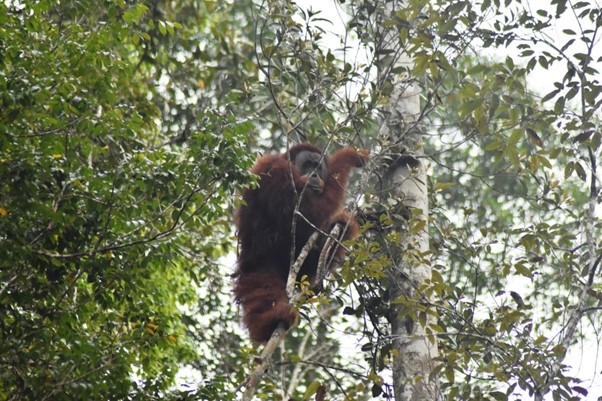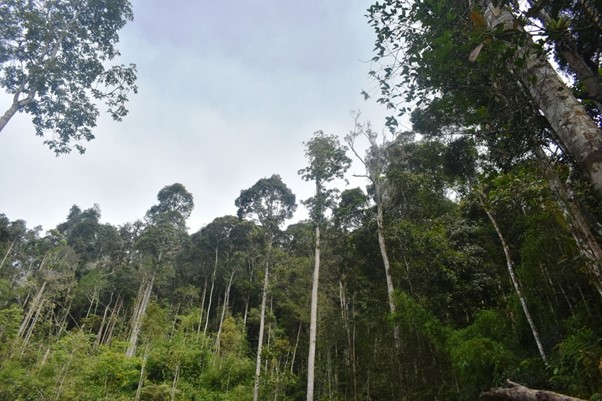Editorial Team
Published on 19 February 2024

 To arrive at these figures, the researchers referred to colonial-era literature, such as newspapers, journals, books, and museum records, from the early 1800s to 2019 by using location-specific keywords such as “Sumatra”, “Batang Toeroe,” and “Tapanoeli,” with Dutch spelling then cross-referenced them with terms that specifically refer to orangutans used commonly in historical literature.
The researchers found that the Tapanuli orangutan historically inhabited a much wider area at a lower altitude than the Batang Toru mountain forest they occupy today. Much of this historical habitat was lost in the 1950s to smallholder agriculture before industrial-scale plantation development in Sumatra emerged in the 1970s. The combination of historical fragmentation of forest habitat and unsustainable hunting is likely to push them from the lowland forest areas, where they used to live, to the upland forests of the Batang Toru ecosystem.
The researchers think that it is likely that Pongo tapanuliensis was hunted to extinction in an increasingly fragmented part of its former home range. They survive in the remote and rocky Batang Toru Mountains which may have protected orangutans from hunting. These findings show that the Tapanuli orangutan is not a species specifically adapted to live in the highlands as some scientists claim.
Map of Sumatra Island showing the current distribution of Pongo tapanuliensis and Pongo abelii, as well as the main areas mentioned in the study. This finding raises concerns over the survival of the Tapanuli orangutan. It is estimated that fewer than 800 of these orangutans live in the Batang Toru forest, divided among three connected subpopulations.
The Tapanuli orangutan species face conflicting threats of hunting and killing, as well as habitat loss due to agriculture and plantations. New threats have also emerged, namely infrastructure development and the construction of hydropower roads, which have caused fragmentation of the remaining habitat of the Tapanuli orangutan.
Conservation experts say the most severe threat currently comes from the Batang Toru hydroelectric power plant. The construction of this hydropower plant is considered to endanger the connectivity between orangutan subpopulations in the west, east, and south. This fragmentation would cut the diversity of the orangutan gene pool dramatically, leading to inbreeding, disease, and, eventually, each subpopulation to extinction.
The researchers calculated that more than one percent of adult orangutans disappear from the wild per year, either being killed, translocated, or captured. With that data, extinction is inevitable, regardless of the initial population size.
Without further rescue efforts, the researchers estimated that this species could become extinct in the next few generations. The ongoing fragmentation of the Batang Toru forest only exacerbates this risk. Onrizal called on all stakeholders, including governments, civil society organizations, scientists, donors, local community representatives, and industry, to develop concrete action plans as soon as possible for the survival of this species.
To arrive at these figures, the researchers referred to colonial-era literature, such as newspapers, journals, books, and museum records, from the early 1800s to 2019 by using location-specific keywords such as “Sumatra”, “Batang Toeroe,” and “Tapanoeli,” with Dutch spelling then cross-referenced them with terms that specifically refer to orangutans used commonly in historical literature.
The researchers found that the Tapanuli orangutan historically inhabited a much wider area at a lower altitude than the Batang Toru mountain forest they occupy today. Much of this historical habitat was lost in the 1950s to smallholder agriculture before industrial-scale plantation development in Sumatra emerged in the 1970s. The combination of historical fragmentation of forest habitat and unsustainable hunting is likely to push them from the lowland forest areas, where they used to live, to the upland forests of the Batang Toru ecosystem.
The researchers think that it is likely that Pongo tapanuliensis was hunted to extinction in an increasingly fragmented part of its former home range. They survive in the remote and rocky Batang Toru Mountains which may have protected orangutans from hunting. These findings show that the Tapanuli orangutan is not a species specifically adapted to live in the highlands as some scientists claim.
Map of Sumatra Island showing the current distribution of Pongo tapanuliensis and Pongo abelii, as well as the main areas mentioned in the study. This finding raises concerns over the survival of the Tapanuli orangutan. It is estimated that fewer than 800 of these orangutans live in the Batang Toru forest, divided among three connected subpopulations.
The Tapanuli orangutan species face conflicting threats of hunting and killing, as well as habitat loss due to agriculture and plantations. New threats have also emerged, namely infrastructure development and the construction of hydropower roads, which have caused fragmentation of the remaining habitat of the Tapanuli orangutan.
Conservation experts say the most severe threat currently comes from the Batang Toru hydroelectric power plant. The construction of this hydropower plant is considered to endanger the connectivity between orangutan subpopulations in the west, east, and south. This fragmentation would cut the diversity of the orangutan gene pool dramatically, leading to inbreeding, disease, and, eventually, each subpopulation to extinction.
The researchers calculated that more than one percent of adult orangutans disappear from the wild per year, either being killed, translocated, or captured. With that data, extinction is inevitable, regardless of the initial population size.
Without further rescue efforts, the researchers estimated that this species could become extinct in the next few generations. The ongoing fragmentation of the Batang Toru forest only exacerbates this risk. Onrizal called on all stakeholders, including governments, civil society organizations, scientists, donors, local community representatives, and industry, to develop concrete action plans as soon as possible for the survival of this species.